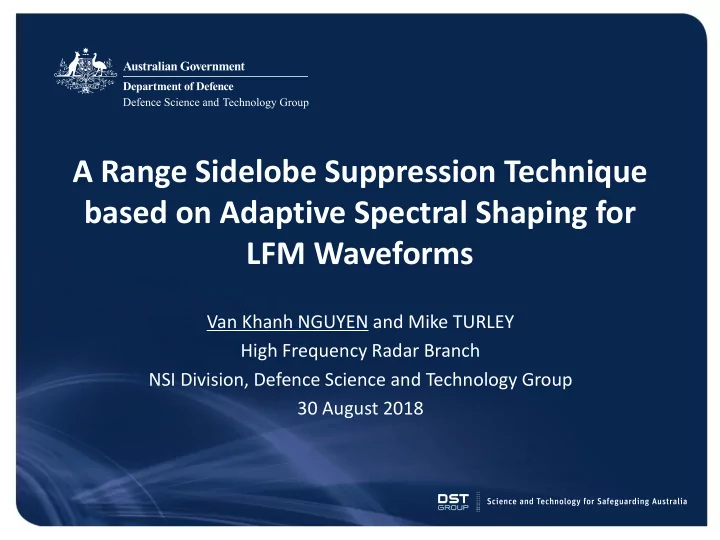

A Range Sidelobe Suppression Technique based on Adaptive Spectral Shaping for LFM Waveforms Van Khanh NGUYEN and Mike TURLEY High Frequency Radar Branch NSI Division, Defence Science and Technology Group 30 August 2018 1
Outline Introduction – range sidelobes Existing range sidelobe suppression techniques Low complexity techniques: spectral shaping – Conventional non-adaptive technique – Proposed adaptive technique Complexity analysis Results Summary 2
Introduction – Range sidelobes Range (km) Range (km) Doppler (Hz) Doppler (Hz) 3
Existing techniques Techniques based on CLEAN – Strong echoes are estimated and subtracted from the received signal – Perform well for discrete point targets but fail in cases of contiguous scattering sources. Adaptive pulse compression techniques – An optimal filter for each range cell – One inversion of a structured covariance matrix for each filter. – Not suitable for radar systems with a high-time bandwidth product. Bandwidth extrapolation techniques – Extrapolate the bandwidth and apply a non-adaptive window over the extrapolated spectral region. – Require estimation of a set of auto-regressive models. Spectral shaping based techniques – Low complexity 4
Signal model Received signal Transmitted waveform Frequency Time # targets # paths # sweeps Transmitted waveform range delay Doppler shift Target return Clutter return 5
LFM waveform Spectral response: Waveform Bandwidth Pulse compression: 6
Non-adaptive spectral shaping Spectral response: Reference waveform: Output: 7
Non-adaptive spectral shaping Without windowing 13dB suppression Conventional range Without processing windowing Power lost With windowing Spectral Sidelobe suppression windowing level Spectral windowing: Various range sidelobe suppression levels Range Range Range Range Doppler Doppler Doppler Doppler 8
Adaptive reference waveform Spectral response: Reference waveform: One reference waveform for each evaluated Doppler bin 9
Proposed adaptive spectral shaping Spectral response: Reference waveform: Output: 10
Proposed adaptive spectral shaping Proposed approach Non-adaptive approach 11
Complexity analysis number of samples per pulse period FFT and IFFT can be efficiently implemented by arithmetic operations Pulse compression: 2 FFT & 1 IFFT of length N r P Non-adaptive spectral shaping: Doppler processing: N r FFT of length P Adaptive reference waveform: requires additional 1 FFT & 1 IFFT of length N r P for each Doppler bin 1 FFT of the data of length N r P Proposed adaptive spectral shaping: requires additional 2 FFT & 1 IFFT of length N r for each Doppler bin 12
Results – Simulated data 1.6 dB gain 0.4 dB gain 1.7 dB gain 0.9 dB gain 13
Results – Real data JORN Transmitter antenna array JORN Receiver antenna array 14
Results – Real data 1.6 dB gain 15
Summary • Problem addressed: – How to adaptively control range sidelobes of target returns for radar systems employing LFM waveforms. • Existing techniques: – CLEAN based techniques – Adaptive pulse compression • Spectral shaping: – Conventional non-adaptive spectral shaping – single reference waveform – Adaptive reference waveform – one reference waveform for each evaluated Doppler bin. – Proposed adaptive spectral shaping – on reference waveform for all evaluated Doppler bins with the spectral shaping being applied after range-Doppler processing • Complexity of the proposed method: less than 2 times that of the conventional non-adaptive spectral shaping. • Performance: SNR gain of around 1.7 dB for weak targets 16
Recommend
More recommend